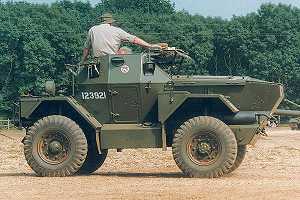 |
The
Ford Lynx Scout Car, manufactured in two major variants at Windsor, Ontario
(3255 units total), was a lightweight reconnaissance vehicle derived from
the successful British Dingo (see below). This particular example was photographed
by Chris Shillito of Armour
in Focus at Beltring '99, where it won Best Overall of the show! It
is truly immaculate. Thank you, Chris! |
|
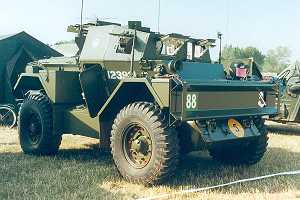 |
Shown
here is the right front quarter of a mid-production Lynx I. This earlier
variant differed from the later Lynx II in exterior stowage arrangements
and in that it had a folding-plate roof which was later eliminated (there
were also changes in steering ratio and axles). Note the open side door
on the driver's side. Armour varied from 30mm in front to 12mm sides and
rear. It was sufficient protection against heavy small arms fire, and the
vehicle relied on its low silhouette and speed to avoid heavier opposition. |
|
 |
The
Lynx looks like a giant, mutant steel beetle. This rear view shows its
bulboue engine compartment, which contained the same 239ci Ford flathead
V8 which characterized all Ford CMP-era vehicles. Wheelbase is a short
81 inches, and overall height 70 inches. With a laden weight of 9370 lbs,
the Lynx was not quick by modern standards, but fairly manoueverable in
tight terrain. Tires are the same 9.00 X 16 size used on many CMPS; shown
here is the familiar 'S-Pattern' runflat probably acquired from a Ferret. |
|
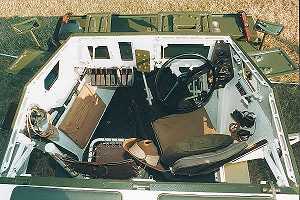 |
A
bird's-eye view of the cramped cockpit shows the unique, angled steering
position borrowed from the Daimler Dingo. Not much room for its two-man
crew! Note the instrument cluster on the right, and a ready rack of eight
Bren magazines immediately in front of the vehicle commander's position
on the left. Behind the commander sits a standard No.19 W/T set. Visibility
is restricted when 'buttoned up', but the objective of these scouting vehicles
was to avoid contact and simply gather information. |
|
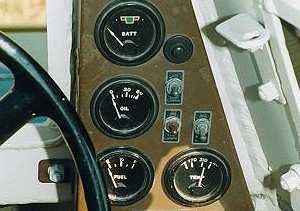 |
The
Lynx instrument cluster is basic CMP, providing the minimum of gauges and
controls to ensure efficient monitoring of operational status. |
|
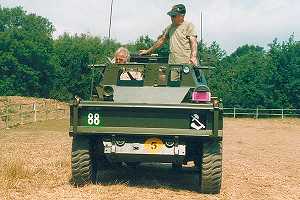 |
The
business end. After the war, overseas stocks of Lynx' were parcelled out
to various European armies along with most of our other vehicles. Few remain
in Canada today, with the last example being brought back from Greece some
time ago. Recently, however, Jim Rice in Alberta recovered a badly-chopped
version from a farmer's field, and is presently engaged in a complete restoration.
See the Restoration Logs for details
as they become available. If anyone has any further information or photographs
of the Lynx, please don't hesitate to contact us! |
|
 |
A
Daimler Dingo Scout Car, the predecessor to the Lynx. Note the similarities
in size and layout. Canadians took several Dingos into the main beaches
at Dieppe on August 19, 1942. |
|
 12 Feb 00
12 Feb 00 |
Back
to CMP Armour |
|
| Copyright ©
Geoff
Winnington-Ball , 1999 - All Rights Reserved |